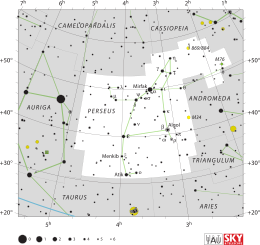| Observation data Epoch J2000.0 Equinox J2000.0 (ICRS) | |
|---|---|
| Constellation | Perseus |
| Right ascension | 03h 11m 17.38161s[1] |
| Declination | +39° 36′ 41.7014″[1] |
| Apparent magnitude (V) | +4.614[2] |
| Characteristics | |
| Evolutionary stage | red clump[3] |
| Spectral type | K0 III[2] |
| B−V color index | 1.122[2] |
| Astrometry | |
| Radial velocity (Rv) | 6.61[2] km/s |
| Proper motion (μ) | RA: −26.26[1] mas/yr Dec.: +5.40[1] mas/yr |
| Parallax (π) | 11.32 ± 0.23 mas[1] |
| Distance | 288 ± 6 ly (88 ± 2 pc) |
| Absolute magnitude (MV) | −0.234[4] |
| Details | |
| Mass | 2.04[2] M☉ |
| Radius | 19[5] R☉ |
| Luminosity | 144.5[2] L☉ |
| Surface gravity (log g) | 2.5[5] cgs |
| Temperature | 4,586±18[2] K |
| Metallicity [Fe/H] | −0.10[4] dex |
| Rotational velocity (v sin i) | 3.3[5] km/s |
| Age | 1.65[2] Gyr |
| Other designations | |
| Database references | |
| SIMBAD | data |
Omega Persei (ω Persei) is a solitary,[7] orange-hued star in the northern constellation of Perseus. The star is faintly visible to the naked eye with an apparent visual magnitude of +4.6.[2] Based upon an annual parallax shift of 11.32 mas as seen from the Earth,[1] the star is about 288 light years from the Sun.
ω Persei has the traditional name Gorgonea Quarta /ɡɔːrɡəˈniːə ˈkwɔːrtə/, being the fourth member of the quartet called the Gorgonea in reference to the Gorgons from the legend of Perseus.[8]
This is an evolved K-type giant star with a stellar classification of K0 III.[2] It is a red clump star that is generating energy via helium fusion at its core.[3] At the estimated age of 1.65 billion years, Omega Persei has double[2] times the mass of the Sun and has expanded to about 19[5] times the Sun's radius. It is radiating 144.5 times the Sun's luminosity from its photosphere at an effective temperature of 4,586 K.[2]
References
- ^ a b c d e f van Leeuwen, F. (2007), "Validation of the new Hipparcos reduction", Astronomy and Astrophysics, 474 (2): 653–664, arXiv:0708.1752, Bibcode:2007A&A...474..653V, doi:10.1051/0004-6361:20078357, S2CID 18759600.
- ^ a b c d e f g h i j k l Luck, R. Earle (September 2015), "Abundances in the Local Region. I. G and K Giants", The Astronomical Journal, 150 (3): 23, arXiv:1507.01466, Bibcode:2015AJ....150...88L, doi:10.1088/0004-6256/150/3/88, S2CID 118505114, 88.
- ^ a b Alves, David R. (August 2000), "K-Band Calibration of the Red Clump Luminosity", The Astrophysical Journal, 539 (2): 732–741, arXiv:astro-ph/0003329, Bibcode:2000ApJ...539..732A, doi:10.1086/309278, S2CID 16673121.
- ^ a b Soubiran, C.; et al. (2008), "Vertical distribution of Galactic disk stars. IV. AMR and AVR from clump giants", Astronomy and Astrophysics, 480 (1): 91–101, arXiv:0712.1370, Bibcode:2008A&A...480...91S, doi:10.1051/0004-6361:20078788, S2CID 16602121.
- ^ a b c d Massarotti, Alessandro; et al. (January 2008), "Rotational and Radial Velocities for a Sample of 761 HIPPARCOS Giants and the Role of Binarity", The Astronomical Journal, 135 (1): 209–231, Bibcode:2008AJ....135..209M, doi:10.1088/0004-6256/135/1/209, S2CID 121883397.
- ^ "ome Per". SIMBAD. Centre de données astronomiques de Strasbourg. Retrieved 2017-06-19.
- ^ Eggleton, P. P.; Tokovinin, A. A. (September 2008), "A catalogue of multiplicity among bright stellar systems", Monthly Notices of the Royal Astronomical Society, 389 (2): 869–879, arXiv:0806.2878, Bibcode:2008MNRAS.389..869E, doi:10.1111/j.1365-2966.2008.13596.x, S2CID 14878976.
- ^ Allen, Richard Hinckley (1899), Star-names and their meanings, G. E. Stechert, p. 334

